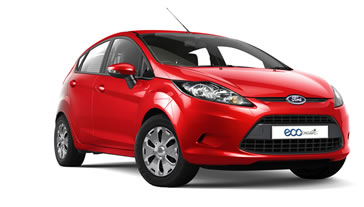-
MATERIAL ISSUES
- Materiality Analysis
-
Climate Change
- Climate Change: Related Commitments and Progress
- Greenhouse Gas Emissions Overview
- Climate Change Risks and Opportunities
- Our Strategy: Blueprint for Sustainability
-
Ford's Sustainable Technologies and Alternative Fuels Plan
- Improving Fuel Economy
- Migration to Alternative Fuels and Powertrains
- Ford's Green Partnerships with the Federal and State Governments
- Progress and Performance
- Climate Change Policy and Partnerships
- Electrification: A Closer Look
- Mobility
- Human Rights
- Vehicle Safety
- Sustaining Ford
- Perspectives on Sustainability
Toolbox
Migration to Alternative Fuels and Powertrains

Advanced Clean Diesel
Ford Fiesta ECOnetic
Ford offers the ECOnetic line of super-fuel-efficient, low-carbon-emission diesel vehicles in Europe. In the United States, we are introducing advanced clean diesel technologies on our diesel truck engines.
| 2007 | 2011 | 2020– 2030 |
|---|---|---|
NEAR TERM Begin migration to advanced technology |
MID TERM Full implementation of known technology |
LONG TERM Continue deploying advanced powertrains and alternative fuels and energy sources |
Advanced Clean Diesel |
||
Modern diesels offer some significant advantages over traditional gasoline engines. They consume 30 to 40 percent less fuel, and on a well-to-wheels basis they emit 15 to 30 percent less CO21 . In addition, direct-injection diesel engines provide exceptional power and torque, resulting in better driving performance and towing capabilities.
In Europe, diesel-powered vehicles account for more than 50 percent of new vehicle sales and make up approximately 30 percent of the total vehicle fleet on the road. Ford continues to improve its strong lineup of fuel-efficient and clean diesel vehicles in Europe. For example, we continue to introduce ECOnetic versions of Ford models that deliver improved fuel economy and emissions. The ECOnetic lineup currently includes versions of the Ford Focus, Mondeo, Fiesta and Transit. Several of the ECOnetic models use diesel engines, which meet the stringent EU V emissions standards and achieve less than 100 g/km C02 emissions. For example, the Fiesta ECOnetic has fuel economy of 3.7 liters/100 km and emits just 98 g/km of CO2. This vehicle is powered by a specially calibrated version of the 90 PowerShift 1.6-liter Duratorq TDCi, combined with a coated diesel particulate (soot) filter.
In North American markets, diesels all but disappeared in the light-duty passenger vehicle market years ago, for a variety of reasons. However, with the introduction of low-sulfur diesel fuels in 2007 and advances in clean diesel technology, there is new opportunity for the expanded use of diesel in North America. Ford engineers are developing next-generation diesel technologies that will maintain the fuel economy advantages of diesels while minimizing emissions to meet strict U.S. air pollution standards. These technologies include diesel particulate filters and NOx-reduction catalysts, along with advanced combustion systems that will significantly reduce the particulate matter and NOx emissions associated with diesel engines. These advances will provide another route to more fuel-efficient and cleaner mobility.
In the North American medium-duty truck market there is a large demand for diesel products, with diesel engines accounting for more than 50 percent of sales. In response to this demand, Ford will introduce, for the 2011 model year, the next-generation F-Series Super Duty® truck with a new state-of-the-art diesel engine. The 6.7-liter PowerStroke® V8 diesel is cleaner and more powerful than previous engines. As a result of the new engine and a transmission upgrade, the 2011 Super Duty will deliver best-in-class fuel economy and towing capability.
This new diesel engine also meets the Environmental Protection Agency's strict 2010 heavy-duty truck emission regulations, which require 80 percent lower NOx emissions than the 2007 regulations. The new Super Duty uses a range of advanced technologies to meet these new regulations. First, the new 6.7-liter PowerStroke engine employs an innovative exhaust gas recirculation system to efficiently recycle the combustion gases. The system runs the engine with the least amount of oxygen possible, in order to reduce NOx emissions without degrading performance and fuel economy. In addition, the Super Duty uses a three-part "after-treatment" system, including:
- a diesel oxidation catalyst that converts and oxidizes hydrocarbons into water and carbon dioxide;
- a selective catalytic reduction that uses an ammonia and water solution to convert the NOx in the exhaust stream into water and inert nitrogen, which is present in the atmosphere and harmless; and
- a diesel particulate filter that traps any remaining soot and periodically burns it away when sensors detect the trap is full.
The engine will also use a high-precision, common-rail fuel-injection system featuring piezo-electric injectors. This system uses a stack of more than 300 wafer-thin ceramic platelets to control the fuel injector nozzle, allowing it to operate faster than other electro-mechanical fuel injectors, to decrease fuel consumption and reduce emissions.
The 2011 Super Duty will also be Ford's first vehicle in North America that is B20 compatible, meaning it can run on fuel composed of 20 percent biodiesel and 80 percent ultra-low-sulfur diesel. Biodiesel is a renewable fuel made from soybean oil and other fats. We went through extensive testing to ensure that the new Super Duty would meet performance and durability requirements when fueled with B20, including running durability cycles on multiple blends of diesel and biodiesel fuels to ensure the robustness of the system. Previously, Ford Super Duty products in North America were approved to use B5 fuel, which is composed of 5 percent biodiesel and 95 percent petroleum diesel. In Europe, our vehicles are also compatible with B5, and we are working with European fuel standards organizations to establish fuel-quality standards for biodiesel blends greater than B5. The use of biodiesel helps reduce dependence on foreign oil and reduces life-cycle CO2 emissions. For more information on biofuels, please see the Renewable Biofueled Vehicles section.